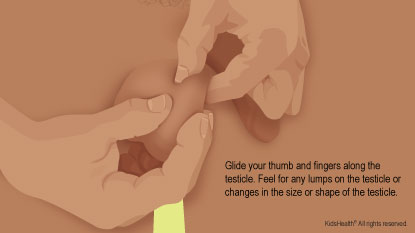Testicular Self-Exam
A testicular self-exam can help you find signs of testicular cancer such as a lump on the testicle or a change in the size or shape of the testicle. Testicular cancer is rare in teens overall, but it is the most common cancer in males between the ages of 15 and 35. Finding it early is important because it is almost always curable if caught and treated early.
How to do a testicular self-exam:
It's best to do the exam during or just after a hot shower or bath. The scrotum (skin that covers the testicles) is most relaxed then, which makes it easier to feel the testicles for lumps or other changes. Examine one testicle at a time.

-
Next, with your free hand, glide your thumb and fingers along the whole surface of the testicle. Feel for any lumps on the testicle (they may be as small as a grain of rice or a pea) or any changes in the size or shape of the testicle.

Doing a testicular self-exam every month will help you get used to what is normal for you. It is normal to feel a lump on the back of the testicles, at the top. This is the epididymis, a tube that carries sperm. It may feel a little tender to touch. It is also normal for one testicle to be slightly larger than the other or for one to hang lower than the other.
If you find any lumps on the testicle or changes in the size or shape of your testicle, call your health care provider. It might not be cancer, but you should be checked as soon as possible. You should also call your health care provider right away if you have achiness or heaviness in the lower belly or scrotum as this also can be a sign of testicular cancer or other problems.